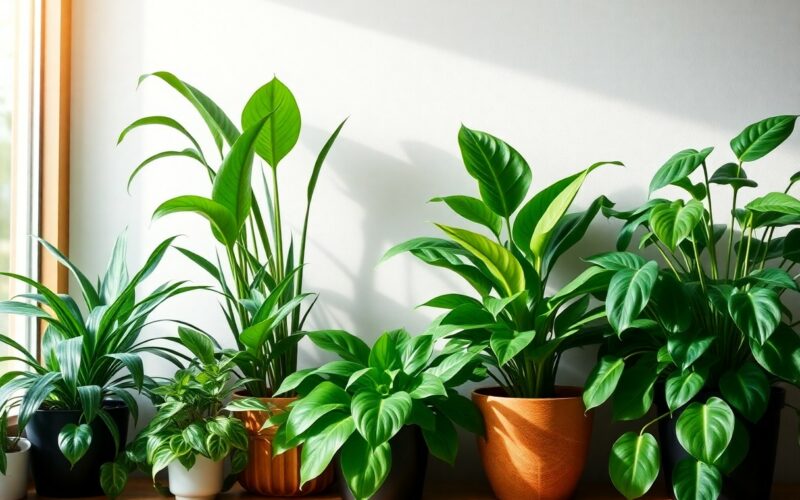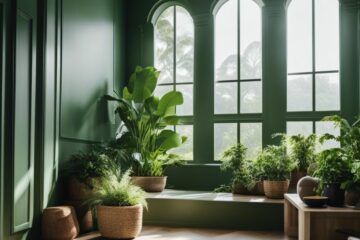With the increasing importance of maintaining a healthy indoor environment, incorporating air purifying houseplants into your home can significantly enhance your air quality. These plants not only add aesthetic value but also help reduce harmful pollutants, making your living space more inviting and safe for you and your family. In this blog post, you will discover the 20 best air purifying indoor houseplants that are perfect for your home, each selected for their ability to detoxify the air while complementing your interior design.
Table of Contents
Key Takeaways:
- Incorporating air-purifying plants like Spider Plant, Peace Lily, and Snake Plant can significantly enhance indoor air quality by removing toxins and pollutants.
- These plants not only improve air purity but also add aesthetic value to your home, creating a more calming and vibrant atmosphere.
- Maintaining these houseplants is typically easy, with low-light and low-water requirements that make them suitable for various living spaces.
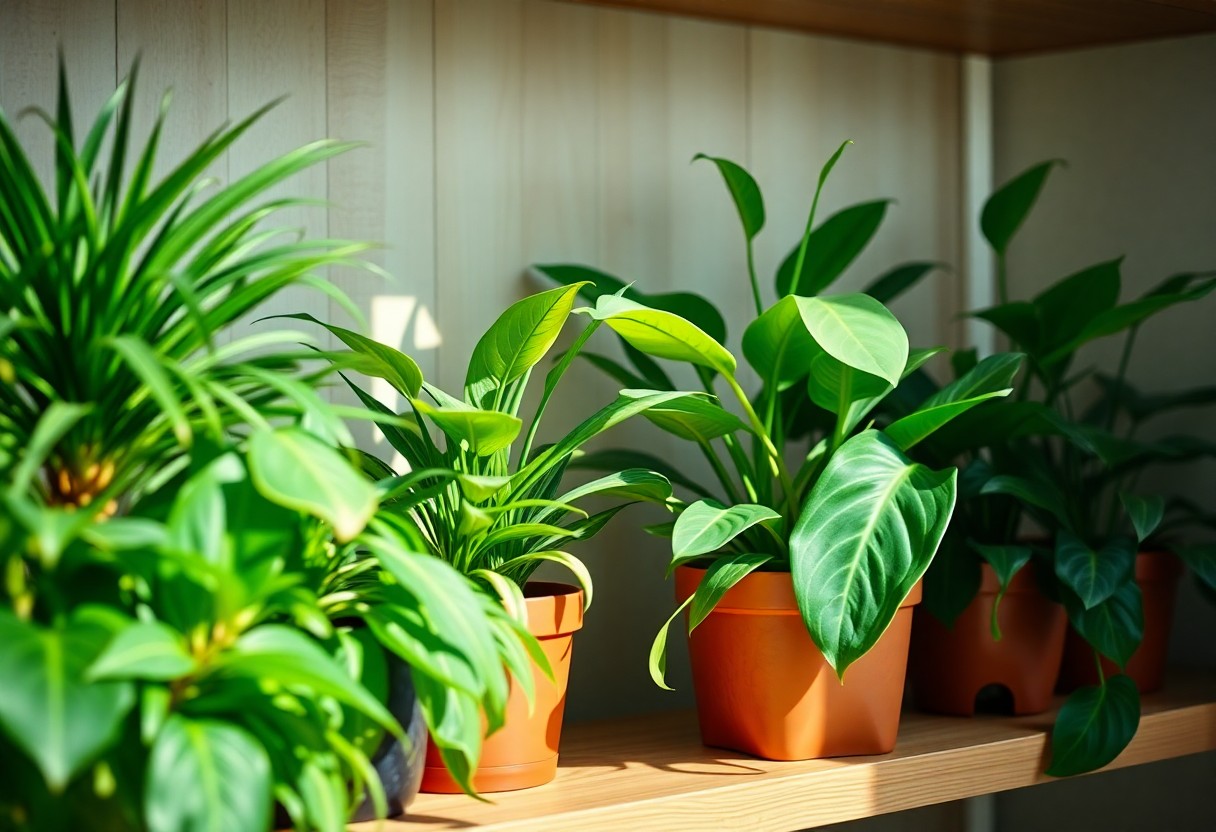
Benefits of Indoor Houseplants
Before you decide on which indoor houseplants to bring into your home, it’s helpful to understand the multifaceted benefits they offer. Not only do they enhance the visual appeal of your living space, but they also provide significant health advantages. Incorporating houseplants into your environment can lead to improved air quality, making your home a more pleasant place to be.
Air Purification
Along with their aesthetic value, indoor houseplants play a vital role in air purification. They absorb carbon dioxide and release oxygen, contributing to a healthier indoor atmosphere. Moreover, certain plants are capable of filtering out harmful substances such as formaldehyde, benzene, and trichloroethylene, which are often present in household products and furnishings. This natural filtration process not only enhances your air quality but can also reduce the risk of respiratory issues and other health problems.
Psychological Well-Being
Houseplants are known to have a positive impact on your psychological well-being. Surrounding yourself with greenery has been shown to reduce stress, increase feelings of relaxation, and promote an overall sense of happiness. Engaging with plants, whether it’s watering them or simply admiring their beauty, can serve as a therapeutic activity that fosters mindfulness and stability in your daily routine.
Also, studies have suggested that having indoor plants can elevate your mood and improve concentration levels, making your workspace more inviting and productive. This harmonic interaction with nature, even indoors, can decrease anxiety levels and uplift your spirits, further solidifying the idea that the presence of indoor houseplants enhances not only your physical environment but your mental clarity and emotional health as well.
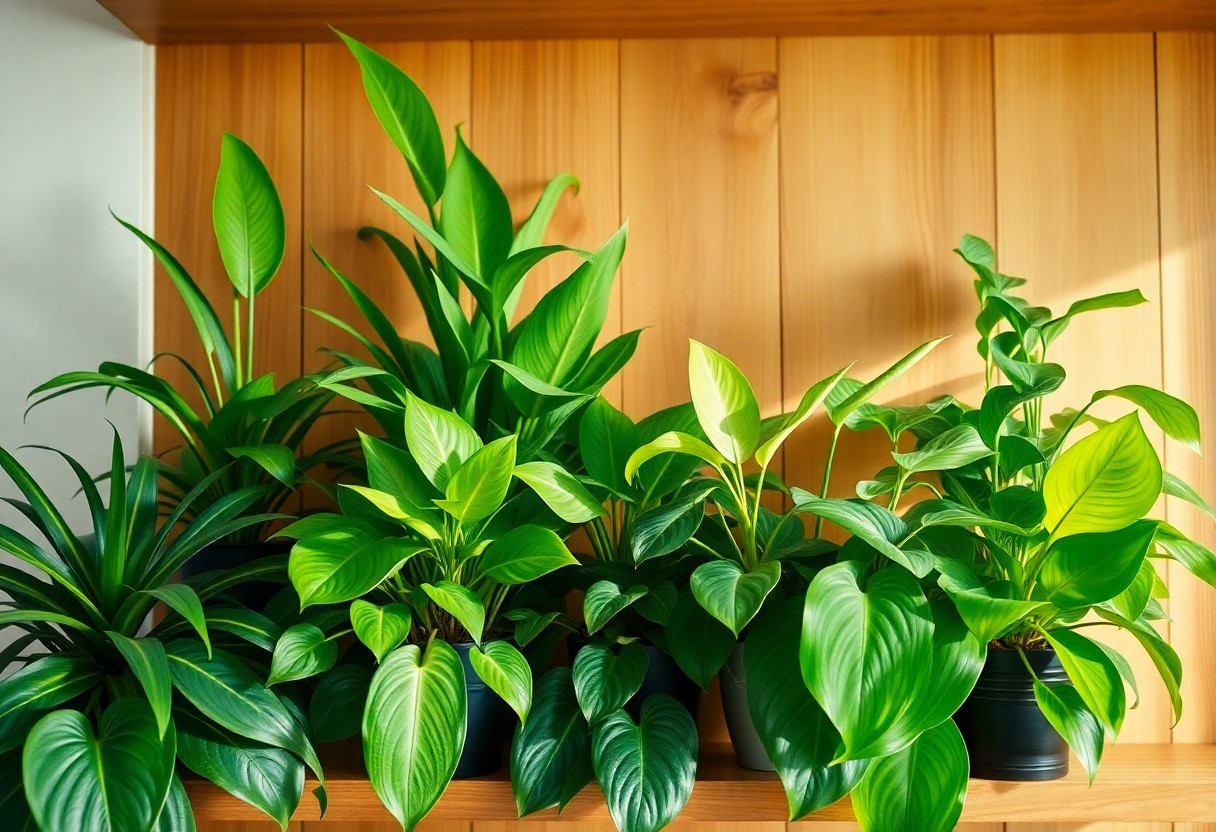
Factors to Consider When Choosing Houseplants
Some factors significantly impact the success of your houseplant journey. Evaluating these elements can help you select the best indoor plants that suit your home environment. Here are a few crucial factors to consider:
- Light availability in your space
- Humidity levels throughout the year
- Available space and the size of the plant
- Maintenance and care required for each plant
- Your personal style and aesthetic preferences
Any successful indoor garden begins with informed decisions, so take the time to assess these factors thoroughly. Making choices based on your lifestyle and environment can lead to a more enjoyable houseplant experience.
Light Requirements
Between the various types of indoor plants, understanding their light requirements is crucial to ensuring their health and longevity. Different plants thrive under different lighting conditions, ranging from full sun to low light. For instance, if you have bright, sunny windows, you may want to consider plants like succulents or snake plants that flourish in such conditions. On the other hand, if your home has minimal natural light, you might opt for low-light tolerant plants like peace lilies or pothos.
Assessing your home’s light conditions will help you pinpoint the ideal plants for your space. Make sure to observe how light enters your rooms throughout the day, as this information will inform your choices. Pairing the right plant with the correct light level enhances your indoor garden’s success rate and allows you to enjoy the air-purifying benefits without stress.
Space and Size
Above all, the physical space available in your home will dictate which houseplants you can grow comfortably. Large, sprawling plants are not suitable for small apartments or rooms with limited surface area, while smaller plants may get lost in oversized spaces. Evaluating the dimensions of your available areas—such as windowsills, countertops, and floor space—will help you make intelligent choices. If you are limited on space, consider using wall-mounted plant holders or hanging planters to maximize your greenery without compromising your living area.
When dicking out plants based on space and size, take into account both the mature size of the plants you want to grow and their potential growth rates. Larger plants can take up valuable real estate in your room, so opting for smaller variants, or regularly pruning larger options can lead to a more balanced and harmonious space. Additionally, some plants may need more vertical growing space, while others may spread horizontally, making spacing considerations even more important. By taking these factors into account, you can create an aesthetically pleasing arrangement of indoor houseplants that not only purify the air but also enhance your home’s ambiance.
Top 20 Air Purifying Indoor Houseplants
For anyone seeking to enhance their indoor environment, integrating air purifying houseplants can be a rewarding and health-conscious choice. These green companions not only elevate the aesthetic of your space but also significantly improve the air quality by filtering out toxins and providing oxygen. To discover a wider selection, check out the 20 Best Bedroom Plants for Oxygen and Feng Shui Energy. With the right plants, you can create a vibrant atmosphere that promotes well-being and relaxation.
Snake Plant
For a resilient and low-maintenance option, the Snake Plant is an excellent choice for your indoor space. It is known for its air-purifying abilities, filtering out harmful pollutants like formaldehyde, benzene, and xylene. Its striking upright leaves add an appealing look to any room, making it a favorite among indoor gardeners. Moreover, this plant thrives in a variety of lighting conditions and only requires infrequent watering, making it perfect for those who may not have a green thumb.
Spider Plant
An exceptional air purifying plant, the Spider Plant is characterized by its long, arching leaves and distinctive green-and-white striped foliage. It effectively removes common indoor air pollutants such as carbon monoxide and formaldehyde, making it a practical addition to your home. Spider Plants are not only easy to care for but also produce small “baby” plants that can be propagated and shared with friends or used to expand your indoor jungle.
Houseplants are often chosen for their aesthetics, but the Spider Plant stands out for its air-cleaning properties as well. By simply placing it near windows or in spaces with indirect light, you can enjoy its benefits while bringing nature indoors. This hardy plant is perfect for beginners and can tolerate a range of conditions, making it a versatile option for different rooms in your home.
Peace Lily
Above all, the Peace Lily is renowned for its elegant white flowers and striking glossy leaves. Not only does it improve air quality by absorbing harmful chemicals such as ammonia and benzene, but it also adds a touch of sophistication to your decor. With the ability to thrive in low-light conditions, this plant is a popular choice for offices and homes alike. Additionally, the Peace Lily is known for its natural ability to increase humidity, which can be beneficial during dry winter months.
Spider away toxins with the Peace Lily in your living space. This beautiful houseplant is celebrated for its easy care routine and forgiving nature, making it an ideal plant for beginners. Regular watering and minimal light requirements ensure that you’ll enjoy its aesthetic appeal and air purification benefits without too much effort.
Boston Fern
To add lush greenery and air purification to your home, the Boston Fern is an excellent option. Its feathery, arching fronds not only make it a visually stunning choice, but this plant is also extremely effective at filtering indoor pollutants such as formaldehyde and xylene from the air. Boston Ferns thrive in humid environments and indirect sunlight, making them ideal for bathrooms or kitchens.
Also, it’s important to keep in mind that the Boston Fern prefers consistent moisture, so regular misting is recommended to keep it healthy and vibrant. With proper care, this plant will flourish and create a serene atmosphere while purifying the air in your home.
Rubber Plant
Above all, the Rubber Plant is known for its large, glossy leaves and impressive height, making it a statement piece in any room. This plant excels at removing indoor air toxins like formaldehyde while also requiring minimal care, which is why it’s often a favorite among indoor plant enthusiasts. Rubber Plants thrive in bright, indirect light and need to be watered only when the top of the soil feels dry, ensuring you can maintain a healthy plant without excessive effort.
In fact, as this plant matures, it can grow into a beautiful centerpiece in your living space. With its aesthetically pleasing form and air-purifying properties, incorporating a Rubber Plant brings both style and health benefits to your home.
Bamboo Palm
Snake your way into improving indoor air quality with the Bamboo Palm, a charming houseplant that effectively filters out toxins while adding a tropical twist to your decor. This plant thrives in low light conditions and is particularly good at filtering out formaldehyde and benzene, making it a perfect choice for bedrooms and living rooms. Its vibrant green fronds can reach impressive heights, creating a tranquil and refreshing atmosphere in your home.
Rubber climate is ideal for this plant, which appreciates regular watering and maintaining high humidity levels. This not only helps the Bamboo Palm flourish but also improves the overall humidity in your home, especially during drier months, thus promoting better respiratory health for you and your family.
Aloe Vera
One of the most popular houseplants, Aloe Vera is known for its soothing properties and exceptional air-purifying abilities. This succulent thrives in bright, indirect light and requires minimal watering, making it an ideal plant for both seasoned plant enthusiasts and beginners. Besides improving indoor air quality, the gel from Aloe Vera leaves can be used to treat minor burns and skin irritations, adding another layer of utility to this stunning plant.
Consequently, keeping Aloe Vera in your home not only brings aesthetic appeal but also serves practical health benefits. With its easy care requirements, you can enjoy cleaner air and have a handy remedy for minor skin ailments right at your fingertips.
Dracaena
Beside enhancing your indoor decor, the Dracaena plant is an excellent air purifier that removes harmful toxins like formaldehyde, benzene, and trichloroethylene. Its striking, architectural shape and colorful leaves add interest to any space, making it a stylish addition to your home. Dracaenas are hardy plants that can easily adapt to different light conditions, ensuring that even in low light, you can keep the air in your home clean.
A little attention to watering and occasional pruning will keep your Dracaena looking its best. With various species available, you can choose the one that fits seamlessly into your aesthetic while still enjoying the air-cleaning benefits.
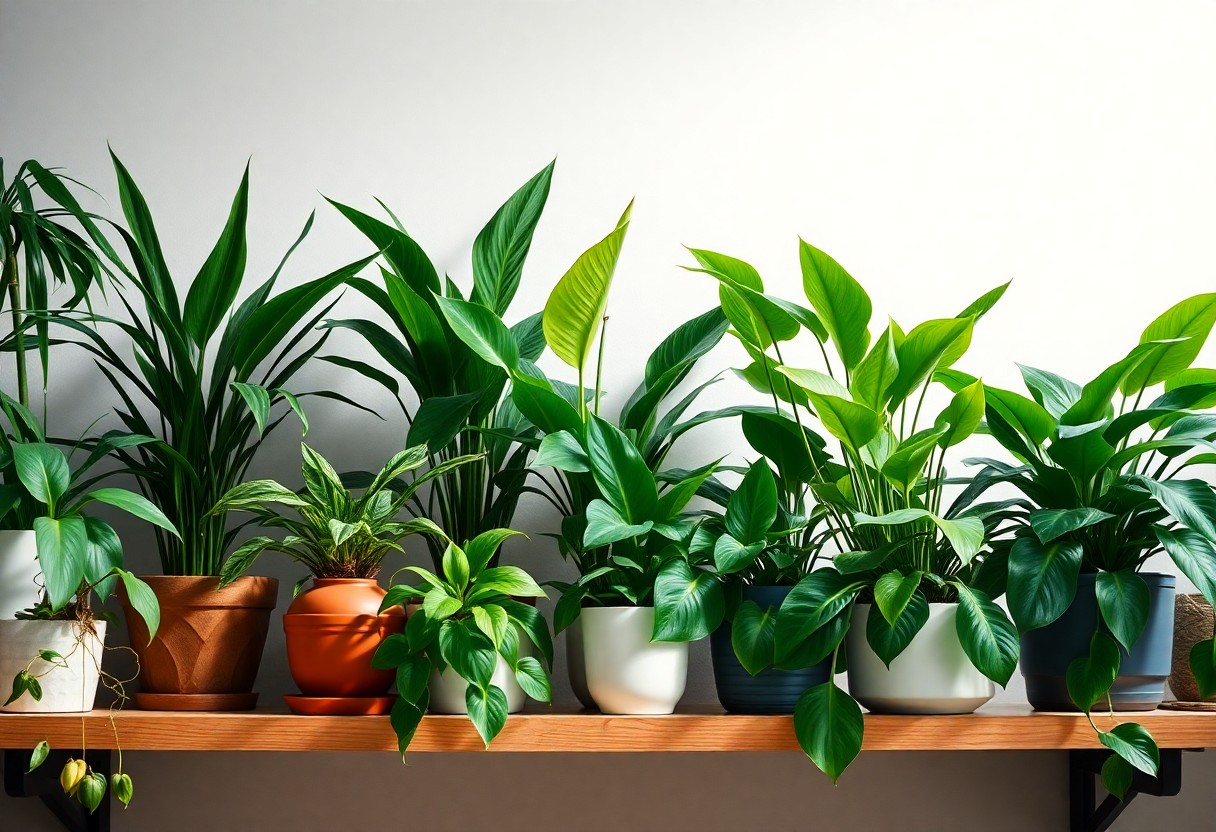
Pothos
Once again, we investigate into the world of indoor plants with Pothos, also known as Devil’s Ivy. This unique plant is not only visually appealing with its beautiful heart-shaped leaves but is also highly effective in purifying the air in your home. Pothos thrives in a variety of conditions, making it an excellent choice for beginners and seasoned plant enthusiasts alike. It can tolerate low light levels and irregular watering, which makes it a flexible and forgiving houseplant.
With its ability to filter out pollutants like formaldehyde, benzene, and carbon monoxide, Pothos is a wonderful addition to any indoor space. You may find it suitable for hanging planters or as a climbing plant, which allows its cascading vines to creatively enhance your interior decor while contributing to a healthier environment.
ZZ Plant
About the ZZ Plant—it is a hardy indoor plant known for its ability to flourish in low-light conditions and with minimal care. Its glossy, dark green leaves add a touch of sophistication to any space, and it thrives on neglect, making it perfect for even the busiest individuals. The ZZ Plant is remarkably resilient to drought, which means you won’t have to worry about constant watering.
This plant not only enhances your home aesthetics but also contributes to better air quality by removing toxins such as xylene and toluene. Its forgiving nature and low maintenance requirement make it a standout choice for anyone looking to introduce greenery into their home without the fuss.
Chinese Evergreen
Above all, the Chinese Evergreen is celebrated for its beautiful variegated leaves and its extraordinary air-purifying abilities. This plant can thrive in a variety of conditions, from bright indirect light to dim areas, making it a versatile addition to your indoor garden. Moreover, it’s relatively tolerant of humidity fluctuations, adding to its appeal as an ideal houseplant.
It is also necessary to note that the Chinese Evergreen may produce compounds that can aid in reducing indoor pollutants to create a more pleasant atmosphere in your home. However, it’s crucial to keep this plant out of reach of pets and small children, as its leaves can be mildly toxic if ingested.
It is important to ensure your Chinese Evergreen is placed in well-draining soil and kept at a temperature above 60 degrees Fahrenheit to help it thrive. With minimal care—like regular watering when the soil is dry—you’ll be rewarded with a vibrant, lush plant that enhances your home’s air quality.
Philodendron
Around the world of houseplants, the Philodendron family is renowned for its diverse species and unique leaf shapes. These tropical plants are not just beautiful; they are also very effective at purifying indoor air. They can acclimate to varying light conditions, although they prefer indirect light, and are relatively easy to care for, making them ideal for busy households or novices in plant care.
Additionally, Philodendrons are particularly known for filtering out formaldehyde and other harmful substances from the air, contributing to a healthier living environment. Their vibrant green foliage can bring a touch of nature indoors, creating a refreshing ambiance in your space.
Plant enthusiasts will appreciate that with proper watering and occasional feeding, your Philodendron can thrive for many years. Pruning spent leaves will also encourage new growth, so you can enjoy a continually lush and vibrant plant.
Ficus Benjamina
The Ficus Benjamina, commonly known as the Weeping Fig, is a striking houseplant that not only adds elegance to your home decor but is also highly effective in improving air quality. This plant features beautiful arching branches covered in small, glossy leaves, which can create a lush atmosphere wherever it’s placed. It prefers bright, indirect light but can adapt to varying light conditions, though changes in light can make it shed its leaves.
Furthermore, the Ficus Benjamina plays a significant role in filtering indoor air toxins, helping to create a healthier environment for you and your family. With its capacity to tolerate moderate neglect, this plant can thrive even in busy households or office spaces.
Benjamina is sensitive to changes in its environment, so be sure to provide a consistent watering schedule, allowing the top inch of the soil to dry out before the next watering. With proper care, it can grow into a magnificent indoor tree, enhancing your space while purifying the air.
Cast Iron Plant
Around the room, the Cast Iron Plant (Aspidistra elatior) stands out for its robust nature and resilience. This plant is named for its tough and durable leaves, which can withstand neglect, low light, and inconsistent watering. It is a superb option for those who may not have a green thumb or find themselves away from home for extended periods.
This hardy plant is also praised for its ability to remove toxins from the air, contributing to a cleaner indoor environment. Its slow growth rate means you don’t have to worry about constantly repotting or reshaping it, making it an attractive choice for busy lifestyles.
Due to its exceptional durability, you can place the Cast Iron Plant in various indoor settings, whether it’s in a dim corner or near a window. As long as it’s not exposed to freezing temperatures, this plant will thrive and remain an enduring part of your indoor collection.
Parlor Palm
Across your living space, the Parlor Palm is a classic indoor plant that brings elegance and versatility. Known for its feathery, arching fronds, this plant can adapt to a variety of conditions, thriving in low light as well as bright, indirect sunlight. Its tropical appearance makes it a favorite among plant enthusiasts who want to add a touch of lushness to their environment.
The Parlor Palm is not only beautiful but also effective at purifying the air, helping to remove toxins and improve overall air quality. Its adaptability and relatively low maintenance requirements make it an excellent choice for busy households or those new to plant care.
Palm trees are usually associated with tropical environments, but the Parlor Palm thrives indoors, making it a perfect houseplant. Be sure to keep the soil slightly moist, as it prefers consistent watering without being waterlogged—a perfect balance that ensures it stays healthy and vibrant.
Lady Palm
Beside your decorative furniture, the Lady Palm (Rhapis excelsa) brings a graceful touch to any indoor area. Renowned for its bushy fronds and multi-stem growth habit, this plant is not only aesthetically pleasing but also extremely efficient in purifying the air. It thrives in various lighting conditions and can adapt to low light levels, making it a suitable choice for your home or office.
Aside from its beauty, the Lady Palm is excellent at filtering harmful substances from the air, such as formaldehyde and ammonia, contributing to healthier indoor spaces. It’s also pet-friendly, making it a great option for families with furry friends.
Hence, if you’re looking for a plant that can elevate your indoor environment both visually and environmentally, the Lady Palm is an excellent choice. With adequate watering and occasional fertilization, it will thrive, providing lush greenery and cleaner air for years to come.
Areca Palm
Plant lovers adore the Areca Palm (Dypsis lutescens) for its beautiful feathery fronds and its ability to purify the air effectively. Often referred to as the butterfly palm, its striking appearance can brighten up any indoor space. The Areca Palm does best in indirect light but can adapt to shadier environments, making it a versatile addition to your home decor.
Additionally, the Areca Palm is particularly notable for its capacity to efficiently remove indoor toxins, including formaldehyde and xylene, enhancing the air quality in your home. This makes it an ideal choice for improving the atmosphere in your living or working spaces.
Also, the Areca Palm requires regular watering and humidity to thrive, making it ideal for bathrooms or kitchens where moisture levels are higher. With proper care, this palm will flourish, bringing a tropical vibe while acting as a natural air purifier.
Jar of Hearts
Hearts are where you find beauty and character, and the Jar of Hearts plant (Hexastylis arifolia) brings both into your home. Known for its heart-shaped leaves with stunning variegations, this plant is not just a sight to behold but also plays a role in purifying the air. Preferring moderate light conditions, it’s an excellent choice for spots that are not overly bright yet still desire a touch of green.
This unique plant thrives in well-draining soil and prefers more humid environments, making it great for bathrooms or kitchens where it can soak up moisture. Its attractive foliage can enhance any space, adding a lively vibe to your indoor setting.
This plant, often overlooked, has a lot to offer as an air-purifier. With proper care, you can ensure your Jar of Hearts remains vibrant, contributing to both the aesthetics of your home and the quality of your indoor air.
English Ivy
With its classic trailing vines and lush leaves, English Ivy (Hedera helix) is a stunning plant that thrives indoors. This versatile climber can be grown in hanging baskets or trained to climb up walls, offering enchanting greenery throughout your space. Beyond its visual appeal, English Ivy is known for its excellent air-purifying properties by removing airborne toxins such as formaldehyde and benzene, helping you breathe easier at home.
Furthermore, it thrives in varying light conditions, from low light to bright, indirect light, making it a flexible choice for any room. Some studies have even indicated its ability to reduce airborne mold levels, creating a healthier environment for you and your loved ones.
Even though it can be relatively easy to care for, it’s important to keep the soil consistently moist and provide adequate humidity levels to prevent leaf drop. By incorporating English Ivy into your indoor garden, you embrace beauty and air quality in your home.
Money Tree
Evergreen in nature, the Money Tree (Pachira aquatica) is cherished for its unique braided trunk and lush green foliage. Frequently associated with good fortune and prosperity, this plant is more than just a symbol; it is also effective at purifying indoor air. The Money Tree thrives in bright, indirect light but can adapt to lower light settings as well, making it a delightful addition to your home or office.
This plant is particularly noted for its ability to filter harmful substances from the air, contributing to overall better indoor air quality. Its growth in water and soil allows you flexibility in how you care for it, while its striking appearance adds a decorative touch to any interior.
Ficus species stand out not just for their aesthetic charm but also for this plant’s low maintenance requirements, making it suitable for beginners. Watering when the topsoil is dry can ensure your Money Tree remains healthy and vibrant, thriving as a striking centerpiece and air-purifier in your living space.
Tips for Caring for Your Indoor Plants
Keep your indoor plants thriving by providing them with the proper care they need. Each type of plant comes with its own set of requirements, but a few universal tips can help you maintain a beautiful indoor garden. To ensure their longevity and health, pay attention to the following:
- Light: Ensure they receive adequate light, whether natural or artificial.
- Humidity: Maintain an appropriate level of humidity for your plants.
- Fertilization: Feed your plants the nutrients they require during their growing season.
- Pruning: Regularly prune for healthier growth and aesthetics.
- Pest Control: Monitor for pests and diseases, and take action if needed.
After adhering to these care tips, your indoor plants will purify your air and beautify your space.
Watering Needs
Before you water your indoor plants, it’s important to understand their specific watering requirements. Different plants have varying needs regarding moisture levels, so knowing when and how much to water can prevent overwatering or underwatering. Elements such as the plant’s size, light exposure, and pot size influence how quickly the soil dries out.
As a general rule, you should check the top inch of the soil; if it’s dry, it’s time to water. Conversely, if it feels moist, hold off until it dries out a bit. Indoor plants often thrive on a consistent watering schedule, adjusting for seasonal changes. Make sure to use pots with good drainage to avoid excess moisture around the roots.
Soil Types
On the subject of soil, keep in mind that different plants prefer different types of soil to flourish. The right mix provides necessary nutrients and ensures proper drainage and aeration. As part of your plant care, select the right soil for your specific indoor plants for optimal growth.
- Well-Draining Soil: Essential for preventing root rot.
- Potting Mix: A versatile option for many houseplants.
- Succulent Mix: Designed for cacti and other succulents.
- Orchid Bark: Ideal for epiphytic plants.
- Seed Starting Mix: Great for germinating new plants.
Assume that you will need to refresh the soil of your plants periodically to ensure the best growth conditions.
| Plant Type | Recommended Soil |
|---|---|
| Ferns | Moisture-retaining soil mix |
| Spathiphyllum | Well-draining potting mix |
| Cacti | Specialty cactus mix |
| Orchids | Orchid bark mix |
| Succulents | Fast-draining soil |
Understanding the optimal soil types for your indoor plants can significantly impact their health and growth. Each soil type offers different properties that cater to specific plant needs. Here are some more soil types to consider:
- Organic Soil: Enhances nutrients through natural matter.
- Peat-Based Mix: Excellent for moisture retention.
- Clay Soil: Can be challenging due to its density.
- Sandy Soil: Drains quickly, good for specific plants.
- Compost: Offers rich nutrients and improves soil structure.
Assume that choosing the right soil is the foundation for successful indoor gardening.
Common Indoor Plant Problems and Solutions
Not everyone can boast of having a green thumb, and even seasoned plant owners may encounter a few common issues with their indoor plants. Recognizing these problems and knowing how to address them is key to ensuring your air purifying houseplants thrive. In this section, we’ll explore some prevalent indoor plant challenges along with effective solutions to help maintain the health of your greenery.
Pests
Solutions for pests often involve inspecting your plants regularly, as early detection is the best defense against infestations. You can use insecticidal soap or neem oil sprays to manage pest populations without harming your plants. Additionally, introducing beneficial insects like ladybugs or predatory mites into your indoor environment can help control unwanted pests in a natural way. Maintaining proper humidity and airflow around your plants will also reduce the likelihood of pest problems developing.
Diseases
Above all, you should be cautious of diseases that can threaten your indoor plants. Fungal infections, for example, may arise from overwatering or poor drainage. Be vigilant and remove any dead or dying foliage promptly, as decaying leaves can harbor pathogens. Additionally, ensuring that your plants have adequate air circulation and light can significantly minimize the risk of disease onset.
Consequently, keeping an eye on your indoor plants’ health is vital to avoiding severe disease outbreaks. You need to observe for any sign of wilting, yellowing leaves, or unusual spots, which may indicate a problem. Promptly addressing such symptoms can prevent diseases from spreading to other plants in your collection. By adopting preventive measures such as proper watering practices and ensuring a balanced environment, you can promote a flourishing indoor garden that contributes positively to your home’s air quality.
Creating a Healthy Indoor Plant Environment
All indoor plants thrive best when they are provided with an optimal environment that replicates their natural habitat. This means focusing on the key elements, such as humidity levels and temperature control, that can significantly affect your plant’s health and growth. By ensuring that your indoor plants are kept in a suitable environment, you will not only keep them healthy but also enhance their air purifying abilities. A well-thought-out environment helps your plants flourish and contribute to a better quality of air in your home.
Humidity Levels
Environment plays a significant role in your indoor plants’ vitality, particularly humidity levels. Many houseplants, especially tropical varieties, prefer environments with higher humidity, usually around 40-60%. When the air is too dry, your plants may exhibit signs of stress, such as browning leaf tips or wilting. You can increase humidity through various methods, such as using a humidifier, grouping plants together, or placing a tray of water near your plants.
Humidity Management Techniques
| Method | Benefit |
|---|---|
| Humidifier | Provides consistent moisture in the air |
| Grouping Plants | Creates a localized humid microclimate |
| Water Tray | Evaporates moisture indirectly around plants |
Temperature Control
Plant growth can be directly impacted by temperature variations within your home. Most houseplants prefer a stable temperature range, generally between 65°F to 75°F during the day. If your indoor plants are exposed to extreme temperature fluctuations or drafts, they may experience stunted growth or even die. It’s important to place your plants away from heating vents, air conditioning units, and cold windows to maintain a stable temperature and foster a more conducive environment for their development.
Temperature Regulation Tips
| Tip | Purpose |
|---|---|
| Position Away from Drafts | Prevents temperature stress on plants |
| Use Thermometers | Monitors internal temperature accurately |
| Avoid Extreme Heat | Protects against leaf scorching and drying |
At the end of the day, maintaining the right temperature is imperative for the overall health of your indoor plants. Whether it’s enjoying the warmth of the sun or being sheltered from the cold, understanding how to regulate the temperature of your plant’s environment makes a big difference. By keeping temperatures on the optimal side, you not only help your plants exude their natural beauty but also enhance their air-purifying properties, creating a healthier indoor atmosphere for you and your family.
To wrap up
Upon reflecting on the benefits of cultivating indoor houseplants, you can certainly see how incorporating some of the 20 best air-purifying plants into your home can vastly improve your living environment. These plants not only act as natural air filters, but they also enhance the aesthetic appeal of your space, making it more inviting and relaxing. From easy-to-care-for varieties like the Snake Plant and Spider Plant to the striking peace and rubber plants, there’s an array of options to suit your preferences and lifestyle. Each plant brings its unique set of qualities to the table, helping you breathe cleaner air while allowing you to showcase your personal style.
As you consider which air-purifying plants would work best for your home, you may want to explore resources like this Which one of these indoor plants are good for purifying air… discussion. Engaging with fellow plant enthusiasts can provide you with insights and tips on how to care for your new green companions effectively. Ultimately, investing time in cultivating these plants will reward you with improved air quality and a sense of well-being in your everyday life. Happy planting!
FAQ
Q: What are the benefits of having air-purifying indoor houseplants?
A: Air-purifying indoor houseplants can dramatically improve your home’s air quality. They have the ability to absorb harmful pollutants such as formaldehyde, benzene, and trichloroethylene from the air. Additionally, they can help increase humidity levels, reduce stress, and enhance overall mood. Incorporating these plants into your space can lead to a healthier and more pleasant living environment.
Q: Which houseplants are recognized for their air-purifying qualities?
A: Some of the best indoor houseplants known for their air-purifying qualities include the Spider Plant, Peace Lily, Snake Plant, Boston Fern, and Bamboo Palm. Each of these plants has been rigorously studied and shown to filter various toxins from indoor air. Selecting a mix of these plants can enhance both their aesthetic value and air purification benefits in your home.
Q: How do I care for air-purifying indoor houseplants?
A: Care requirements vary depending on the type of plant, but general guidelines include providing the appropriate amount of light, maintaining consistent watering schedules, and ensuring proper drainage. Most air-purifying plants thrive in indirect light and prefer to dry out slightly between waterings. Regularly dusting the leaves can help them efficiently absorb pollutants, and fertilizing during the growing season can promote healthy growth.
Q: Are air-purifying plants safe for pets and children?
A: While many air-purifying plants are non-toxic and safe for pets and children, some, like the Peace Lily and Philodendron, can be toxic if ingested. It’s important to research each specific plant before bringing it into your home and consider your household’s safety. Opting for non-toxic plants is always a wise choice, especially in homes with pets and small children.
Q: How many air-purifying plants do I need for effective air filtration?
A: The effectiveness of air-purifying plants depends on various factors, including the size of the room and the number of plants. A common guideline suggests one plant per 100 square feet of space for optimal air purification. However, having multiple plants can enhance the overall aesthetic and provide a greater degree of air filtration, so it’s beneficial to incorporate several varieties throughout your home.

Our contributing author is a passionate advocate for eco-friendly living and sustainability. With a background in eco-life, they are dedicated to inspiring and empowering individuals to adopt environmentally conscious lifestyles. Through insightful articles, they share practical tips, innovative solutions, and thought-provoking perspectives to promote a greener, more sustainable world. Join them on the journey towards eco-smart living and discover how small choices can make a big impact. 🌱

